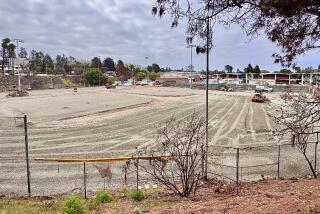Mountain Hamlet’s Students Return to Real Campus
- Share via
LEE VINING, Calif. — Mike Wiles, 17, is loath to admit it too loudly. This isn’t the sort of thing a teenager ‘fesses to, not in public. But he kind of, sort of, really didn’t mind returning to school here a couple of weeks ago.
That’s because he finally had a school to return to.
Back in fall 1998, a boozed-up pair of students broke into venerable Lee Vining High School and began setting trash-can fires. One spread. Lee Vining High--50 students strong--burned nearly to the ground.
Residents were outraged, angry--and worried.
Some townsfolk questioned whether a tiny high school in an isolated community shadowed by the eastern Sierra could justifiably be rebuilt. Fiscal conservatives in the town of 300 talked of wasted tax money.
Maybe the students should be bused south, some suggested, carted each day to the big high school in booming Mammoth Lakes.
But school officials and their supporters pressed ahead, through tense times with insurers and state education officials and engineers, through the regulatory maze of design and construction.
The end product, delivered half a year later than expected, is a high school that looks disarmingly like the original. The same gently sloping roof line, bolstered to support heavy snow in this region of harsh winters. The same classroom layout. An all-new wood floor in the gym, but the same basic architectural footprint.
But better. Along with new interior walls, paint and double-paned windows, the school has an expanded network of computers, a new wood shop, an auto shop, an improved science program.
“It’s sort of been like Christmas morning for the kids,” said Principal Hugh Qualls. “They’d never admit it, of course, but it was a nice present. The idea of a new high school has been a myth to them the last few years.”
For the past two school years, students have survived in cramped quarters. First there was the local church. Pews were moved aside by the students on Mondays, replaced with school tables. Juniors and seniors crowded into the church kitchen, freshmen and sophomores next to the pulpit beneath a wooden cross.
Later they relocated to modular trailers parked next to the elementary school, across the wind-swept highway that divides this town at the back door of Yosemite National Park. Cabin fever, always a factor in the long winters of these parts, grew intense. The volleyball and basketball teams had to commute to Mammoth to play.
“If you wanted to do sports, you had to travel,” recalled Wiles, a senior lineman on the football team. “You didn’t have a locker or anything. You had to truck your books all over, every classroom, take them home at night.”
Students also took to wondering when the new school would ever be finished. Qualls tried humor to soften them up, joking with the teenagers that he felt less like a principal and more like a trailer park manager. It helped a bit, but the reality only sank deeper.
“It didn’t even feel like we were going to high school,” said Marcela Quinonez, 16, a junior. “We didn’t have any more spirit. We just wanted to get it over with.”
Some of the teenagers remain angry at the boys who ignited the 1998 blaze. Both admitted guilt and spent about six months in a juvenile detention facility.
One returned last year to Lee Vining High, found a place on the school’s eight-man football team, and shrugged off barbs from former friends. He regained a measure of respect in the process.
The other, a youth with Olympic potential in snowboarding, never went back to Lee Vining High. Instead, he enrolled at an alternative school. In the eyes of his peers, he has been largely unrepentant.
“It hasn’t changed much,” Wiles said. “I guess there’s still some anger.”
And there is also a little hope.
The football team has a new scoreboard, a new locker room and great expectations for a better season. Enrollment, a problem for the school in the last decade, is up a bit and officials hope it will rise in the years to come.
Support from parents remains solid. The weekend before school started, Qualls wanted to put a trophy case in the lobby before Monday morning.
But parents beat him to it. The principal arrived that weekend to find half a dozen adults dusting off trophies and fiddling with screwdrivers.
The next day, the doors swung open.
“It feels good, actually,” said Robert Garnica, 17. “We’re in a real school again--lockers and all that. A gym to play in. Being back here is pretty cool.”
More to Read
Sign up for Essential California
The most important California stories and recommendations in your inbox every morning.
You may occasionally receive promotional content from the Los Angeles Times.













